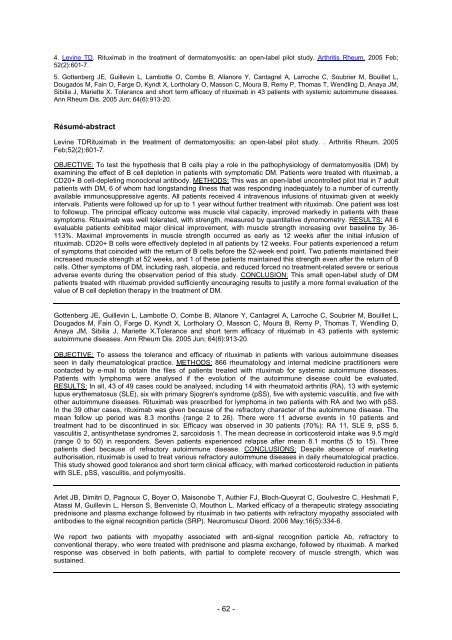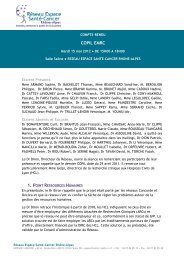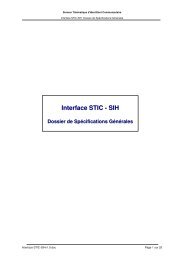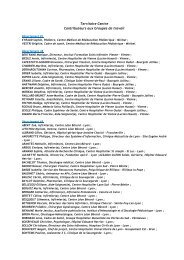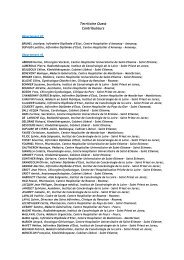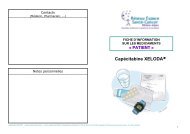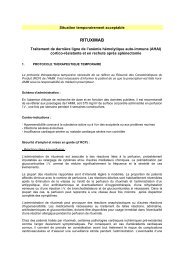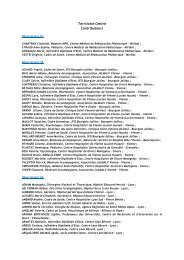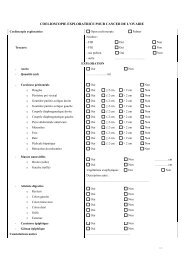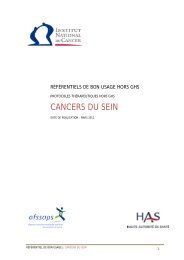rituximab
rituximab
rituximab
Create successful ePaper yourself
Turn your PDF publications into a flip-book with our unique Google optimized e-Paper software.
4. Levine TD. Rituximab in the treatment of dermatomyositis: an open-label pilot study. Arthritis Rheum. 2005 Feb;52(2):601-7.5. Gottenberg JE, Guillevin L, Lambotte O, Combe B, Allanore Y, Cantagrel A, Larroche C, Soubrier M, Bouillet L,Dougados M, Fain O, Farge D, Kyndt X, Lortholary O, Masson C, Moura B, Remy P, Thomas T, Wendling D, Anaya JM,Sibilia J, Mariette X. Tolerance and short term efficacy of <strong>rituximab</strong> in 43 patients with systemic autoimmune diseases.Ann Rheum Dis. 2005 Jun; 64(6):913-20.Résumé-abstractLevine TDRituximab in the treatment of dermatomyositis: an open-label pilot study. . Arthritis Rheum. 2005Feb;52(2):601-7.OBJECTIVE: To test the hypothesis that B cells play a role in the pathophysiology of dermatomyositis (DM) byexamining the effect of B cell depletion in patients with symptomatic DM. Patients were treated with <strong>rituximab</strong>, aCD20+ B cell-depleting monoclonal antibody. METHODS: This was an open-label uncontrolled pilot trial in 7 adultpatients with DM, 6 of whom had longstanding illness that was responding inadequately to a number of currentlyavailable immunosuppressive agents. All patients received 4 intravenous infusions of <strong>rituximab</strong> given at weeklyintervals. Patients were followed up for up to 1 year without further treatment with <strong>rituximab</strong>. One patient was lostto followup. The principal efficacy outcome was muscle vital capacity, improved markedly in patients with thesesymptoms. Rituximab was well tolerated, with strength, measured by quantitative dynomometry. RESULTS: All 6evaluable patients exhibited major clinical improvement, with muscle strength increasing over baseline by 36-113%. Maximal improvements in muscle strength occurred as early as 12 weeks after the initial infusion of<strong>rituximab</strong>. CD20+ B cells were effectively depleted in all patients by 12 weeks. Four patients experienced a returnof symptoms that coincided with the return of B cells before the 52-week end point. Two patients maintained theirincreased muscle strength at 52 weeks, and 1 of these patients maintained this strength even after the return of Bcells. Other symptoms of DM, including rash, alopecia, and reduced forced no treatment-related severe or seriousadverse events during the observation period of this study. CONCLUSION: This small open-label study of DMpatients treated with <strong>rituximab</strong> provided sufficiently encouraging results to justify a more formal evaluation of thevalue of B cell depletion therapy in the treatment of DM.Gottenberg JE, Guillevin L, Lambotte O, Combe B, Allanore Y, Cantagrel A, Larroche C, Soubrier M, Bouillet L,Dougados M, Fain O, Farge D, Kyndt X, Lortholary O, Masson C, Moura B, Remy P, Thomas T, Wendling D,Anaya JM, Sibilia J, Mariette X.Tolerance and short term efficacy of <strong>rituximab</strong> in 43 patients with systemicautoimmune diseases. Ann Rheum Dis. 2005 Jun; 64(6):913-20.OBJECTIVE: To assess the tolerance and efficacy of <strong>rituximab</strong> in patients with various autoimmune diseasesseen in daily rheumatological practice. METHODS: 866 rheumatology and internal medicine practitioners werecontacted by e-mail to obtain the files of patients treated with <strong>rituximab</strong> for systemic autoimmune diseases.Patients with lymphoma were analysed if the evolution of the autoimmune disease could be evaluated.RESULTS: In all, 43 of 49 cases could be analysed, including 14 with rheumatoid arthritis (RA), 13 with systemiclupus erythematosus (SLE), six with primary Sjogren's syndrome (pSS), five with systemic vasculitis, and five withother autoimmune diseases. Rituximab was prescribed for lymphoma in two patients with RA and two with pSS.In the 39 other cases, <strong>rituximab</strong> was given because of the refractory character of the autoimmune disease. Themean follow up period was 8.3 months (range 2 to 26). There were 11 adverse events in 10 patients andtreatment had to be discontinued in six. Efficacy was observed in 30 patients (70%): RA 11, SLE 9, pSS 5,vasculitis 2, antisynthetase syndromes 2, sarcoidosis 1. The mean decrease in corticosteroid intake was 9.5 mg/d(range 0 to 50) in responders. Seven patients experienced relapse after mean 8.1 months (5 to 15). Threepatients died because of refractory autoimmune disease. CONCLUSIONS: Despite absence of marketingauthorisation, <strong>rituximab</strong> is used to treat various refractory autoimmune diseases in daily rheumatological practice.This study showed good tolerance and short term clinical efficacy, with marked corticosteroid reduction in patientswith SLE, pSS, vasculitis, and polymyositis.Arlet JB, Dimitri D, Pagnoux C, Boyer O, Maisonobe T, Authier FJ, Bloch-Queyrat C, Goulvestre C, Heshmati F,Atassi M, Guillevin L, Herson S, Benveniste O, Mouthon L. Marked efficacy of a therapeutic strategy associatingprednisone and plasma exchange followed by <strong>rituximab</strong> in two patients with refractory myopathy associated withantibodies to the signal recognition particle (SRP). Neuromuscul Disord. 2006 May;16(5):334-6.We report two patients with myopathy associated with anti-signal recognition particle Ab, refractory toconventional therapy, who were treated with prednisone and plasma exchange, followed by <strong>rituximab</strong>. A markedresponse was observed in both patients, with partial to complete recovery of muscle strength, which wassustained.- 62 -


